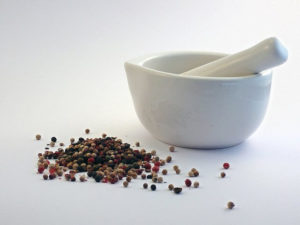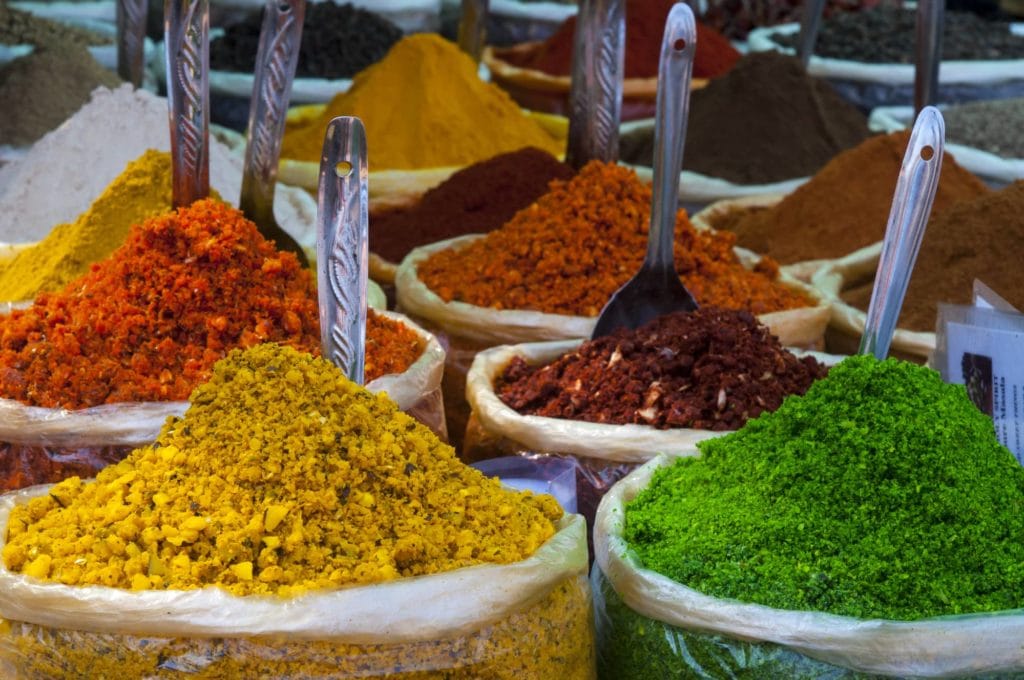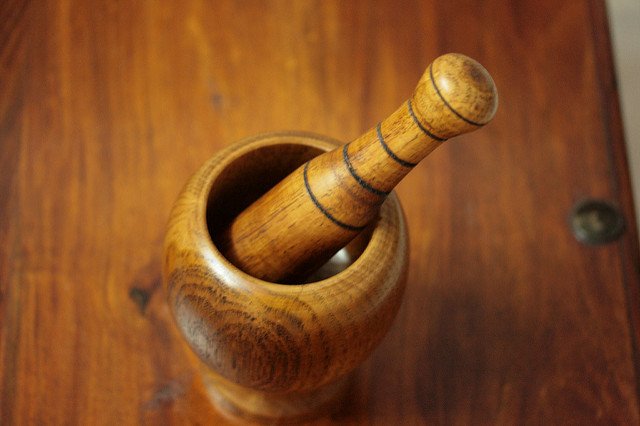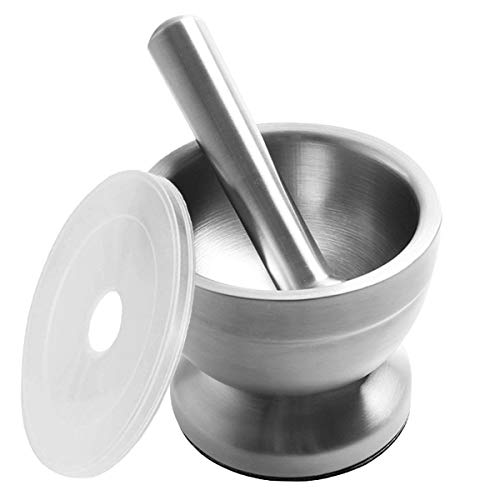
Choose a mortar and pestle for your grinding!
In this current day and age, items of convenience are all around us − especially in the kitchen.
From hand mixers to egg poachers, there is usually a fancy tool or genius innovation for any kitchen task you can think of.
However, sometimes items used in more older times make a comeback and can be celebrated for their simplicity and usefulness. The mortar and pestle are just one of these older tools.
| Best Mortar & Pestle | Material |
|---|---|
| 1. ChefSofi Granite Mortar & Pestle Set | granite |
| 2. Cooler Kitchen EZ-Grip Silicone & Porcelain Mortar | silicone and porcelain |
| 3. Flexzion Brushed Stainless Steel Mortar and Pestle Set | stainless steel |
| 4. X-cosrack Mortar and Pestle Set | granite |
| 5. HIC Porcelain Mortar and Pestle | porcelain |
| 6. Vasconia 4-Cup Granite Molcajete Mortar and Pestle | granite |
| 7. White Marble Mortar and Pestle | white marble |
Are you running low on time? My favorite on this list is the ChefSofi Granite mortar and pestle set from Amazon.
A traditional way to grind spices.
Are you thinking about running to the nearest kitchen supply store to pick up the latest and greatest newfangled spice grinder? Why not try your hand pressing spices in a mortar and pestle instead?
Using a mortar and pestle to grind spices helps each individual spice release its flavorful oils and fragrances. Grinding the spices by hand lets you really get the perfect amount of each spice if you’re concocting your own spice blend.
Get those spices under control with the best kitchen drawer inserts for spices!
Mortar and Pestle Versus Cutting and Mincing
When you use a mortar and pestle to grind your spices instead of cutting them, you are effectively expelling the essential oils found in the spice while also taking full advantage of its flavor. The flavor of these plants is trapped inside them, so they need to be crushed in order to get to that full bodied flavor. You can’t release the flavor as well with a knife as you can with crushing them.
Believe it or not, with a mortar and pestle, there is also far less bruising than there would be with a knife mincing them or even a food processor. You aren’t generating as much friction as quickly when you crush the spices yourself. The food processor goes quickly and generates a lot of heat.
What exactly are a mortar and pestle?
A mortar and pestle are as simple as it sounds! The mortar is a solid bowl, usually made out of wood, stone or ceramic. A pestle is an accompanying tool used to grind spices into smaller grounds. These tools were used before the advent of kitchen supply stores and were often used for grinding medicinal herbs as well as herbs for cooking.
Although a mortar and pestle can be used for making wonderfully hand-mashed guacamole or pesto, it is primarily used to grind larger freshly picked or dried spices into a smaller and more usable form.
A mortar and pestle combination brings a little bit of the old world back into your kitchen when you choose to use it over newer technology, like a food processor or other spice grinder.
Do a mortar and pestle make food taste better?
This question is left to the chefs to answer, so I’ll take the word of the chefs at Osteria Mozza − a high-end restaurant located in Los Angeles − when they say they use this tool for things like romesco and aillade.
Many chefs truly believe that foods taste better when using a mortar and pestle. Some even say when you use a mortar and pestle for garlic or even basil, you aren’t going to be met with that bitter taste you can get when chopping them with a knife. The color also stays more in tact because of less bruising and heat.
Why do mortar and pestles make food tastier?
A few reasons really, some scientific and some not.
Take for example one of my favorite ingredients, garlic. Putting garlic in a food processor, you run the risk of heating the garlic turning it bitter. Plus, food processors don’t give you that chunky texture that so many of us love in our puree’s.
The other reason isn’t so scientific and is likely just the placebo effect that comes with knowing you put some extra love into grinding your spices, rather than dumping into some fancy doodad that does all the work for you.
Why should I have a mortar and pestle to grind my own spices?
Let your inner caveman (or woman of course) come out. The mortar and pestle are easily one of the most primitive tools; you’re literally putting your food in a bowl and clubbing it into little chunks. Is there anything better than that? NO! So… that’s why.
But really, if you can spare the small amount of cabinet space that a mortar and pestle will take up, I highly suggest you make the switch and start grinding your own spices.
Grinding your own fresh or dried spices is likely to be less expensive than buying ground spices at the grocery store. Likewise, growing your own herbs and drying them out will be equally cost-effective.
A huge benefit you can count on if you choose to use a mortar and pestle for your spice grinding is that you know exactly what is going into your spices or spice blends.

A mortar and pestle will help you grind your spices like a professional for better-tasting flavor.
Some spice blends sold in stores have added salts or other unknown spices added to prevent clumping.
Although nobody likes a clumpy container of spices, this can be avoided by keeping your own dried spices on hand and grinding them as needed. You get freshly ground spices with the added bonus of knowing exactly what’s going into your spices and food.
For those of us watching our sodium intake or who must avoid certain spices altogether, making your own blends avoids the uncertainty of using prepackaged spices from the store. Plus, it’s just fun!
What to Look for in a Mortar and Pestle
Now that you are aware of the advantages that can be had with a mortar and pestle over food processors and knife cutting, it’s time to learn what to watch for when purchasing your own mortar and pestle for the kitchen.
The Size
You don’t want a small and cheaply made mortar to grind your spices in. The pestle shouldn’t be too narrow, skinny, or short either if you have a larger mortar. The pestle should never be shorter than the mortar, or you will find it nearly impossible to use it as intended.
Type of Mortar
You will find that most of the time a stone mortar is going to be the best option. Marble and solid granite, for example, are durable and dense and lets you use the force needed when crushing and grinding your spice blends. These stone materials are also a lot stronger than ceramic and will not crack or chip as easily. Wood is another material you can find, but it is often far less effective than a stone kitchen tool.
The Shape
When choosing the mortar, it should be evenly round so that it is easier to use the pestle. If there are any sharp corners, the pestle will not be able to get into those tight areas so you won’t be able to grind everything down as well as you can with a more cylindrical shape.
The Interior
You should also find a mortar that doesn’t have a polished interior. When it is polished and smooth, you are losing out on the abrasive qualities you want when grinding your spices and releasing all that flavor.
If those bulk batches of spices are cluttering up your kitchen, you might want to read my how-to on keeping your pantry organized.
Now that we’ve got some info on why you should get you this old as time tool, let’s look at some of the best models.
ChefSofi Mortar and Pestle set
Personally, I love stone mortar and pestle sets like this one.
Granite is a beautiful element, and not just in appearance. In fact, without it, the stone age would never have even happened − who knows where we would be as a species without that. The rigid surface of stone makes it a perfect tool, especially for grinding down spices.
This particular mortar is large enough to grind large batches of spices together. And of course, the stone pestle is sturdy enough to make grinding as easy as possible considering you are doing it by hand.
You may run into run rather frustrating issue with the granite surface. Because it has such a smooth surface, the first couple of uses may be troublesome with your spices sliding around the bowl rather than grinding.
Cooler Kitchen EZ-Grip Silicone & Porcelain Mortar
Porcelain is a decent material for grinding your spices. The smooth, non-porous, surface ensures your spices don’t absorb into the material allowing you to use this set on any number of spices without worry of cross-contamination.
This is a simple and inexpensive tool that is dishwasher safe with silicone grips on the bottom of the mortar and the top of the pestle that is comfortable to hold, plus keep your tools grounded in their designated spots.
The biggest issue I typically have with anything made from porcelain is the fragile nature of the material. This can become a problem with a mortar and pestle because the entire purpose of the tool is to grind, pound, and smash your food. Porcelain doesn’t always hold up well in that environment.
Flexzion Brushed Stainless Steel Mortar and Pestle set
Stainless steel is always an appealing option for large and small kitchen appliances alike, and it’s no different for mortar and pestles. The brushed stainless steel adds a nice contemporary touch to an ancient tool. Maybe it isn’t the best surface for crushing spices, but it is certainly one of the most appealing designs.
This mortar/pestle set gives you an incredible 2 cup capacity, with a wide opening for easy crushing. Plus, the beautiful finish of the bowl makes it great for using as a serving dish once your guacamole is completed. The non-slip rubber bottom is a useful addition as well!!!
One of the biggest benefits of a stainless steel mortar is that it is extraordinarily easy to clean. Food wipes off the stainless steel surface with ease. But don’t be fooled, the strict “no soap policy” is still in play here. Rinse with warm water only.
X-cosrack Mortar and Pestle Set
You may have realized that granite is my personal favorite surface for a mortar and pestle. The reason is two-fold:
- Granite makes the tool look more primitive, which is something I love
- Granite is the perfect surface for grinding. It is coarse enough to grip spices and break them down easily, and smooth enough to keep grit from building up
This set from X-cosrack has a copper base and also includes an anti-slip pad to sit the mortar on.
This is definitely a quality product; however, the interior of the stone is very porous. I certainly wouldn’t recommend this for crushing medicines, but man it makes for a perfect surface when grinding herbs, peppers, or anything else down to a fine powder.
HIC Porcelain Mortar and Pestle
This is a pretty good low-cost option, for those of us on strict budgets. It isn’t a particularly large mortar, but it works well enough for mixing small portions of spices, and the pouring spout makes it incredibly easy to transfer your mix from the mortar to its final destination.
Although it is a porcelain set, the inside of the mortar has a rough, coarse surface to help you finely grind your spices to powder form.
The downside of this set is the size of it, the bowl only holds roughly a cup of spices, and the wooden pestle is pretty small as well – making it difficult to maneuver if you have bigger hands.
What type of mortar and pestle should I be adding to my kitchen arsenal?
First-time users can certainly be overwhelmed with the different options when trying to decide on a suitable set for their kitchen.
Some models are made from wood or stone, whereas others are crafted from sleek materials like marble or ceramic. There are even cast iron and stainless steel sets!
Wooden or stone sets

Although wooden or stone sets may seem more earthen and natural, these materials can actually be too porous for spices.
The idea is that the rough interior helps with the grinding, but the problem is that residue can eventually become lodged in the pestle. This shouldn’t be an issue if you’re planning on only grinding one spice.
The material largely depends on how you want to use it. If you intend on grinding a multitude of spices, you should choose a mortar and pestle that is resistant to staining and leaching of flavors.
Best use of a wooden mortar and pestle
The wooden versions of this tool are a double edge sword really. The huge benefit you get from it is that the flavor of the spices you grind is retained by the mortar due to the porous nature of the wood. It is also the lightest option to choose from when looking at materials.
That same porous nature that leaves you with a well-seasoned mixing bowl is also a detriment at times, occasionally leaving unwanted flavors in your spice mix.
These are best used for the same purpose each time. The wood absorbs water, and harmful microorganisms love this so you may be looking at disaster with long and repeated use of a wooden mortar and pestle set.
Ceramic or stone sets
For a mortar and pestle set that will effectively grind spices down to a fine pressed powder, without absorbing all the flavors and oils into the pestle, opt for a ceramic or stone set.
This type of mortar and pestle is effective at grinding spices to your desired coarseness without the issue of leftover flavors. No one wants to grind down rosemary for a dish and taste turmeric in the finished product!
Best uses for ceramic mortar and pestle
Ceramic sets are typically favored for making pestos, and similar mixes. Not generally used for grinding spices into fine powders, instead used for lightly bruising ingredients. Ceramic material isn’t that strong and may break during the grinding process.
It can also crack and chip much more easily than other materials, and this can happen during the grinding process as well. Ceramic sets are brittle and may not be resistant to stains but can be conditioned by grinding sand to provide some texture and give a rough surface to the smoother interior.
Stone materials like marble aren’t as brittle, but they can still break. Repeated use breaks down the particles, and when used to crush or grind acidic foods, you will find that a marble mortar is quite sensitive.
Glass Sets
There are glass mortar and pestle sets are available for purchase. Unfortunately, many find this material far too fragile for the intended use. I can’t recommend smashing two pieces of glass into one another. They do make fine decorative pieces, though!
Stainless Steel
While stainless steel is definitely durable, you will find that the interior is much too polished and slick. When you try to grind your spices and herbs, they may move around and slide too much making the process much more difficult. However, stainless steel mortar and pestle sets would definitely be a lot easier to clean than other types and it is definitely not porous.
An alternative to stainless steel is cast iron. It offers a hard surface that has many of the same advantages you can find with stone materials; however, the cast iron may react negatively with acidic ingredients and to avoid rust, it is extremely important that you wash and dry the mortar and pestle immediately after each use. They also need to be seasoned with oil regularly.
Mix it up!
Be sure to consider your personal needs before selecting a mortar and pestle for your own use at home. Choose one based on material, and also on size. To summarize:
- If you know you won’t be grinding a large number of spices and herbs at once, a smaller model is great!
- Alternatively, if you grow your own spices and grind a large batch at once, you probably require a larger model
- Choose a material that is appropriate for the types of materials you’ll be grinding
Fresh Habaneros? Here’s how to dehydrate them without a dehydrator
Most importantly, have fun, and forget everything mom said about not playing with your food! The best dishes are those cooked with love and a little elbow grease.
And, for those of you interested in doing it yourself in the kitchen, learn all about the best pressure canner for canning meats or check out this post on the best dehydrators for mushrooms.
Sources













Alexis DeAnda is a food fanatic, library card user, and cast iron hunter, in that order. She has been cooking for anyone that will taste it ever since her mom let her make doughnuts on Saturday mornings at the age of 7.